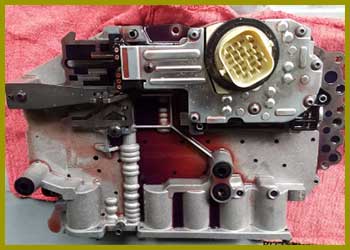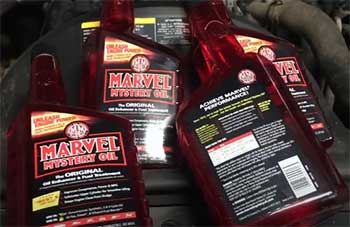The 545RFE solenoid pack is a key component in your transmission, effectively acting as the nerve center. When it’s working correctly, you’re blissfully unaware of its existence.
However, if it starts going bad, it can throw a wrench in your vehicle’s smooth operation.
Let’s dive into understanding the symptoms of a 545RFE solenoid pack going bad, their potential implications, and how to identify them.
The Anatomy of the 545RFE Solenoid Pack

To truly grasp the symptoms, you need to understand what a solenoid pack does.
In layman’s terms, a solenoid pack in a transmission is a combination of solenoids that function together to control the transmission’s fluid flow.
The operation of these solenoids either allows or restricts the transmission fluid, determining gear shifts and overall transmission function.
Recognizing the Symptoms of a Failing 545RFE Solenoid Pack
Now, let’s look at the signs of a malfunctioning solenoid pack. Knowing these symptoms can help prevent further damage and possibly save you from a costly repair bill.
- Unpredictable Gear Shifts
Your vehicle’s smooth and timely gear shifting largely depends on the solenoid pack. If your transmission starts to shift gears unexpectedly or refuses to shift at all, this is a classic symptom of a faulty 545RFE solenoid pack.
- Transmission Slippage
Experiencing a sudden loss of power while driving or feeling that your vehicle isn’t accelerating as it should? This could be transmission slippage – another symptom of a failing solenoid pack.
The erratic supply of transmission fluid may cause the transmission to ‘slip’ between gears, which can feel like you’re losing control.
- Transmission Overheating
A malfunctioning 545RFE solenoid pack can cause improper fluid flow, leading to your transmission overheating. If your vehicle’s temperature gauge is reading higher than usual, it’s time to investigate.
- Check Engine Light
While this can indicate various issues, if the check engine light comes on alongside other symptoms mentioned, it’s likely your solenoid pack might be failing.
- Poor Fuel Economy
If your vehicle is suddenly guzzling fuel faster than usual, it could be because of a solenoid pack problem. The irregular gear shifts and fluid supply can significantly affect your fuel economy.
- Delayed Gear Engagement
If your vehicle’s gears take a long time to engage after shifting, this could be a sign of a bad solenoid pack. This delay is typically most noticeable when shifting from “Park” to “Drive” or “Reverse.”
- Vehicle Stuck in Limp Mode
A severe symptom of a failing solenoid pack is when your vehicle enters what’s called “limp mode.” This is a protective measure activated when the computer system in your vehicle detects a severe issue.
In this mode, your car will be limited to a lower speed and fewer gear ranges to prevent further damage.
- Strange Noises
If you’re hearing unusual sounds, like grinding or buzzing, when your vehicle is shifting gears, it could be an indication of a solenoid pack problem. These noises might be due to the incorrect flow of transmission fluid caused by a faulty solenoid.
Maintenance Tips for a 545RFE Solenoid Pack
- Address Symptoms Early

As we’ve discussed, symptoms of a failing 545RFE solenoid pack can be quite noticeable.
Address these issues early to avoid further damage to the pack or the overall transmission system.
Remember, the key to longevity of any vehicle part is proactive care and maintenance.
The solenoid pack is no exception! Regular inspections and fluid changes, along with careful driving, can ensure a healthy, functional solenoid pack and transmission system.
- Regular Inspection
One of the key maintenance tips is regular inspection. Ensuring your solenoid pack is checked periodically by a professional will help you identify any potential issues before they escalate.
- Keep Up with Transmission Fluid Changes
The solenoid pack controls the flow of transmission fluid. Hence, keeping up with your vehicle’s recommended transmission fluid change schedule is vital. Also, always use the manufacturer-recommended fluid.
- Avoid Aggressive Driving
Aggressive driving can put unnecessary stress on the transmission and, by extension, the solenoid pack. Try to maintain smooth, steady driving habits to reduce wear and tear.
Also Read: 2014 Ford F150 Transmission Issues.
FAQs About 545RFE Solenoid Pack
As described above, signs like erratic gear shifts, transmission slippage, overheating, an illuminated check engine light, and poor fuel economy can all indicate a faulty solenoid pack.
When a transmission solenoid fails, it disrupts the flow of transmission fluid, affecting the operation of your transmission. This leads to unexpected gear shifts, transmission slippage, overheating, reduced fuel economy, and potentially, complete transmission failure.
When a pressure control solenoid goes bad, it fails to regulate the fluid pressure in the transmission system. This can lead to harsh or delayed gear shifts, causing a jarring driving experience.
A solenoid pack in a transmission controls the flow of transmission fluid, allowing the correct operation of the transmission and facilitating smooth gear shifts.
Wrapping Up
Understanding the symptoms of a 545RFE solenoid pack going bad is the first step to avoiding major mechanical issues. Remember, early detection of these symptoms can be the difference between a minor repair job and a major expense.
When in doubt, consult a professional mechanic to help diagnose and address the issue.

